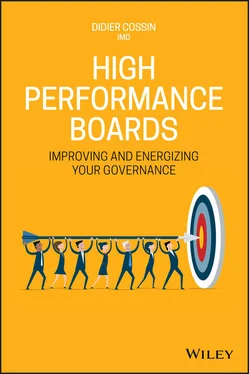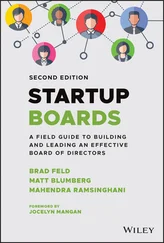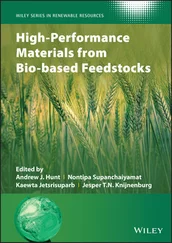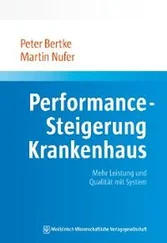Description: Chichester, West Sussex : John Wiley & Sons, 2020. | Includes index.
Identifiers: LCCN 2019056741 (print) | LCCN 2019056742 (ebook) | ISBN 9781119615651 (cloth) | ISBN 9781119615682 (adobe pdf) | ISBN 9781119615699 (epub)
Subjects: LCSH: Boards of directors. | Corporate governance.
Classification: LCC HD2745 .C644 2020 (print) | LCC HD2745 (ebook) | DDC 658.4/22—dc23
LC record available at https://lccn.loc.gov/2019056741
LC ebook record available at https://lccn.loc.gov/2019056742
Cover Design: Wiley
Cover Image: © sorbetto/Getty Images modified by Wiley
Author Photo credit: Headshot Pro, Christophe Senehi
Didier Cossinis professor of governance at IMD, Switzerland. He is the founder and director of the IMD Global Board Center, the originator of the Four Pillars of Board Effectiveness methodology and an advocate of Stewardship.
Prof. Cossin works with sovereign wealth funds, large corporations, non-profit organisations, families and institutional investors on governance and stewardship issues. He is an advisor to central banks, regulators and international organizations across the world.
He is the author of other books such as Inspiring Stewardship, book chapters (such as Governance Risk: A Guide for Investors) and articles in the fields of governance, investments, risks and stewardship. He is also principal author of a proprietary methodology of investment selection on governance that is used in financial markets.
Prof. Cossin holds a PhD in Business Economics from Harvard University (Robert C. Merton chair), is a former Fulbright Scholar from the Massachusetts Institute of Technology and is a graduate from ENS, rue d’Ulm, Paris as well as of Sorbonne University and EHESS.
Many have contributed, directly and indirectly, to my work and to this book. Of those that contributed directly, I am particularly indebted to Sophie Coughlan and Abraham HongZe Lu. Both Sophie and Abraham have helped me directly in my practice and shaped several of the chapters of this book. This book would not be there without their contribution. I am also grateful for the many others that contributed to this work: Quentin Dufresne, Francesca Vitucci, Julie Poivey, Martin Kralik, Richard Eames. And for a personal collaboration that has addressed many of the issues hereby described, Loic Frank.
Of those that contributed indirectly, I owe a particular debt to the real actors of the governance world, board members, directors, government officials, investors, that have peopled my words and my ideas, for the better or for the worse! They probably are just as happy to not see their name mentioned here, as a chair of one of the largest financial institutions in the world wryly remarked once: “Being in Didier’s writings tells you it’s time to go!”. I suppose that my critical eye has helped a few towards self-awareness J. For many though, they have been an inspiration of how to drive true governance, and many of them are chairpeople or board members of influential and powerful organizations. I am grateful for all those who shared intimate and confidential situations that make the reality of good and bad governance. Without them, I could not contribute to governance improvements that I know impact the world for the better (and sometimes dramatically and publicly so). The dedication, integrity, and altruism of many is commandable. Some are famous, some are unknown, and all support us towards a better governed world. And indeed I have rarely met individuals that did not want to do better, in all senses of the word better. We, as society, should always support the development and improvement of those that govern us and our organisations, and I hope that through my words, their contribution will be heightened. I am in many ways a go-between, putting in words and concepts what the very best-in-class are naturally doing. This book is simply a mapping and synthetization of what some gifted and dedicated individuals have endeavored to bring to society through their personal judgement skills.
Governance, or the quality of decision-making at the very top of an organisation, has become central to success. But although an effective board can be a huge asset in this regard, boards often fail their organisations – typically in the areas of risk management, strategy, the selection and support of the CEO and senior management, and integrity. Making boards more effective, therefore, is crucial to improving governance around the world.
My own interest in the subject began more than 30 years ago, when I studied the governance of risk. I was fortunate to have many inspirational teachers, including five Nobel Prize winners – one of whom, Robert C. Merton, chaired my PhD committee. In parallel with my mathematical work, I quickly became convinced that the human element is crucial to effective governance, and my interest in psychology, philosophy, and ethics increasingly shaped my approach.
In the decades since, I have worked with boards across the globe to assess and improve governance – in big global companies, sovereign wealth funds, government bodies, international organisations, non-profits, family businesses, and tech start-ups. Over the years, I have developed a systematic approach to increasing a board's effectiveness that rests on four pillars: the quality, focus, and dedication of individual directors; sophisticated information architecture; well-functioning structures and processes; and, healthy group dynamics and board culture. By focusing on continuous improvement across all four dimensions, my methodology has repeatedly shown its ability to transform boards for the better.
Diagnosing governance problems is often relatively straightforward, although in some rare cases the causes can be deep and hidden, especially with integrity failures. Improving governance, on the other hand, is often a longer-term process, requiring a gradual, sustained effort over several years.
This book covers both the diagnosis and treatment of governance problems, and aims to provide directors with a practical guide to making their boards more effective. Part I introduces the Four Pillars of Board Effectiveness methodology that my team and I use to assess governance health. Readers may wish to think of this section as a check-up process. Part II addresses the most common areas of governance failure, and how boards can guard against these. Finally, Part III is a compendium of best-in-class governance practices, with each chapter covering a specific aspect of board work.
My colleagues at IMD business school, and especially the team at the IMD Global Board Center, have contributed hugely to the content of this book. So, of course, have the thousands of board members whom I have had the pleasure of working with. I pay tribute to them in this book by describing the board experiences of a character called Joanne Marker (not her real name). The real Joanne, an exceptional woman of great energy and dedication, has softly (and sometimes not so softly) impacted the governance of three of the world's most iconic large-cap companies and one of its most influential philanthropic organisations.
As Joanne's experiences illustrate, good governance is about balance, responsibility, and genuine personal accountability. I therefore hope the following chapters will inspire you and your organisations to even better governance and further success.
Didier Cossin
Lausanne, January 2020
PART I The Four Pillars of Board Effectiveness
Joanne Marker and Board Service
October 2018: At age 69, Joanne Marker had been a senior independent director for over 20 years on the boards of many different companies and public organisations .
Читать дальше












